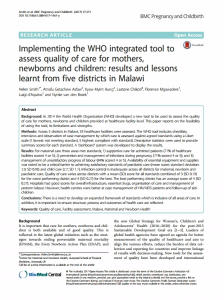
Background
In 2014 the World Health Organization (WHO) developed a new tool to be used to assess the quality of care for mothers, newborns and children provided at healthcare facility level. This paper reports on the feasibility of using the tool, its limitations and strengths.
Methods
Across 5 districts in Malawi, 35 healthcare facilities were assessed. The WHO tool includes checklists, interviews and observation of case management by which care is assessed against agreed standards using a Likert scale (1 lowest: not meeting standard, 5 highest: compliant with standard). Descriptive statistics were used to provide summary scores for each standard. A ‘dashboard’ system was developed to display the results.
Results
For maternal care three areas met standards; 1) supportive care for admitted patients (71% of healthcare facilities scored 4 or 5); 2) prevention and management of infections during pregnancy (71% scored 4 or 5); and 3) management of unsatisfactory progress of labour (84% scored 4 or 5). Availability of essential equipment and supplies was noted to be a critical barrier to achieving satisfactory standards of paediatric care (mean score; standard deviation: 2.9; SD 0.95) and child care (2.7; SD 1.1). Infection control is inadequate across all districts for maternal, newborn and paediatric care. Quality of care varies across districts with a mean (SD) score for all standards combined of 3 (SD 0.19) for the worst performing district and 4 (SD 0.27) for the best. The best performing district has an average score of 4 (SD 0.27). Hospitals had good scores for overall infrastructure, essential drugs, organisation of care and management of preterm labour. However, health centres were better at case management of HIV/AIDS patients and follow-up of sick children.
Conclusions
There is a need to develop an expanded framework of standards which is inclusive of all areas of care. In addition, it is important to ensure structure, process and outcomes of health care are reflected.